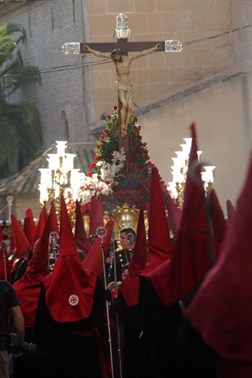The Holy Week of Murcia
 Holy Week in Murcia is a true Baroque spectacle. Between Good Friday (Viernes de Dolores), the preceding Palm Sunday and Easter Sunday (Domingo de Resurrección), the fifteen town confraternitiesSince the moment when almost all of the Cofradías of Murcia transported more than a simulacrum in procession, the brothers have been divided into Hermandades (Brotherhoods), which carry their respective pasos. The Real, Muy Ilustre, Venerable y Antiquísima Archicofradía Preciosísima de la Sangre de Nuestro Señor Jesús Cristo (Royal, Most Illustrious, Venerable and Ancient Archconfraternity of the Precious Blood of Our Lord Jesus Christ), better known as the Brotherhood of Los Coloaros, established in 1411, owns 14 of them and is divided into the same number of Hermandades (comprised of 3,500 brothers). (Cofradías) organize sixteen processions. In those days, thousands of brothers file out in penance (the Nazarenos) and carry on their shoulders (the Estantes) the beautiful pageants of Holy Week. There are nearly a hundred wooden simulacra which are finely decorated, many of which are the work of the famous Baroque sculptor of Italian descent Francisco Salzillo (1707-1783). These effigies are called pasos, the name by which the Spaniards indicate the groups of statues depicting the most memorable scenes of the Passion of Jesus and the individual statues depicting the figures of Christ and the Virgin Mary. The Good Friday Procession is also called de los SalzillosThe Good Friday processions in Murcia were held quarterly. The most famous is the one organized by the Real y Muy Ilustre Cofradía de Nuestro Padre Jesús Nazareno (Royal and Most Illustrious Confraternity of Our Father Jesus the Nazarene), better known as the de los Salzillos procession, named after the Italian-born sculptor of Murcia Francisco Salzillo (1707-1783). Francisco Salzillo was the author of eight of the nine pasos carried in procession by the brothers of Jesus the Nazarene, excluding the seventeenth-century image which bears the same name., since almost all of the pageants that parade in it were made by the sculptor of that name (masterpieces now kept in a special museum dedicated to him). On the website http://www.regmurcia.com there are photos and videos of the entire Holy Week of Murcia, a full list of the confraternities, the description of the pasos and processions. The duration of the parades, the huge number of the members involved and the antiquity of Murcia’s pasos make it one of the most beautiful and intense Holy Weeks in the world, like those that take place in other locations in Spain such as Malaga and Seville. In 2011, the Holy Week of Murcia was declared by the Spanish government to be of International Tourist Interest.
Holy Week in Murcia is a true Baroque spectacle. Between Good Friday (Viernes de Dolores), the preceding Palm Sunday and Easter Sunday (Domingo de Resurrección), the fifteen town confraternitiesSince the moment when almost all of the Cofradías of Murcia transported more than a simulacrum in procession, the brothers have been divided into Hermandades (Brotherhoods), which carry their respective pasos. The Real, Muy Ilustre, Venerable y Antiquísima Archicofradía Preciosísima de la Sangre de Nuestro Señor Jesús Cristo (Royal, Most Illustrious, Venerable and Ancient Archconfraternity of the Precious Blood of Our Lord Jesus Christ), better known as the Brotherhood of Los Coloaros, established in 1411, owns 14 of them and is divided into the same number of Hermandades (comprised of 3,500 brothers). (Cofradías) organize sixteen processions. In those days, thousands of brothers file out in penance (the Nazarenos) and carry on their shoulders (the Estantes) the beautiful pageants of Holy Week. There are nearly a hundred wooden simulacra which are finely decorated, many of which are the work of the famous Baroque sculptor of Italian descent Francisco Salzillo (1707-1783). These effigies are called pasos, the name by which the Spaniards indicate the groups of statues depicting the most memorable scenes of the Passion of Jesus and the individual statues depicting the figures of Christ and the Virgin Mary. The Good Friday Procession is also called de los SalzillosThe Good Friday processions in Murcia were held quarterly. The most famous is the one organized by the Real y Muy Ilustre Cofradía de Nuestro Padre Jesús Nazareno (Royal and Most Illustrious Confraternity of Our Father Jesus the Nazarene), better known as the de los Salzillos procession, named after the Italian-born sculptor of Murcia Francisco Salzillo (1707-1783). Francisco Salzillo was the author of eight of the nine pasos carried in procession by the brothers of Jesus the Nazarene, excluding the seventeenth-century image which bears the same name., since almost all of the pageants that parade in it were made by the sculptor of that name (masterpieces now kept in a special museum dedicated to him). On the website http://www.regmurcia.com there are photos and videos of the entire Holy Week of Murcia, a full list of the confraternities, the description of the pasos and processions. The duration of the parades, the huge number of the members involved and the antiquity of Murcia’s pasos make it one of the most beautiful and intense Holy Weeks in the world, like those that take place in other locations in Spain such as Malaga and Seville. In 2011, the Holy Week of Murcia was declared by the Spanish government to be of International Tourist Interest.
